You'll transform your home's comfort and efficiency with these ten air heating upgrades. Start by evaluating your current system and choosing compatible solar collectors. Install ductwork for solar integration and connect it to your existing HVAC. Implement smart control systems and optimize air distribution methods. Enhance insulation throughout your home and incorporate backup heat sources for reliability. Don't forget to regularly monitor and maintain your system's performance. From solar-powered HVAC to thermal storage solutions, these upgrades blend cutting-edge technology with time-tested methods. Discover how each improvement can markedly boost your home's heating capabilities and energy savings.
Assess Your Current Heating System

Before diving into upgrades, take a close look at your existing heating system. Determine its age, efficiency rating, and overall condition. Check for any visible signs of wear or damage, such as rust, leaks, or strange noises.
Review your energy bills from the past few years to gauge your system's performance and identify any sudden increases in consumption.
Next, schedule a professional inspection to get an expert opinion on your system's health. They'll assess the heat exchanger, burners, and other essential components.
Ask about your system's estimated remaining lifespan and whether repairs or a full replacement would be more cost-effective.
Consider your home's layout and insulation quality. Are there cold spots or drafts? These issues might indicate problems with your ductwork or insulation rather than the heating system itself.
Don't forget to examine your thermostat's functionality and accuracy.
Choose Compatible Solar Collectors
After evaluating your current heating system, you might consider incorporating solar collectors to enhance your home's energy efficiency. To choose compatible solar collectors, you'll need to assess your home's structure, location, and energy needs.
First, determine if your roof can support solar panels. Consider its orientation, angle, and available space. South-facing roofs with a 30-45 degree tilt are ideal for maximum sun exposure. If your roof isn't suitable, ground-mounted systems are an alternative.
Next, evaluate your climate and local weather patterns. In sunny regions, photovoltaic panels may be more effective, while solar thermal collectors work well in cooler climates. Consider seasonal variations and potential obstructions like trees or nearby buildings.
Match the collector type to your heating system. For forced air systems, solar air heaters can be integrated directly. Water-based systems benefit from flat plate or evacuated tube collectors. Heat pump systems can be paired with PV panels to power the unit.
Lastly, calculate your energy requirements and size the system accordingly. Factor in your home's insulation, average energy consumption, and desired savings. Consult with a solar professional to guarantee proper sizing and compatibility with your existing heating system.
Install Ductwork for Solar Integration

When integrating solar collectors into your home heating system, you'll need to carefully consider the placement options for ideal sunlight exposure.
You'll also want to guarantee your ductwork is properly sized to accommodate the additional airflow from the solar heating system.
Solar Collector Placement Options
For ideal solar heating integration, strategic placement of solar collectors is essential. You'll want to position them where they'll receive maximum sunlight exposure throughout the day. Typically, this means facing south in the Northern Hemisphere or north in the Southern Hemisphere.
Consider the angle of your roof and any potential obstructions like nearby buildings or trees that could cast shadows on your collectors.
When planning your solar collector placement, keep these factors in mind:
- Roof orientation and pitch
- Local climate and weather patterns
- Seasonal sun path variations
- Aesthetic impact on your home's exterior
- Local building codes and regulations
You might opt for roof-mounted collectors, which are most common and often the most efficient. However, ground-mounted or wall-mounted options can work well in certain situations.
If you have limited roof space or unfavorable roof orientation, these alternatives could be viable solutions. Remember that the efficiency of your solar heating system depends largely on proper collector placement.
It's worth consulting with a solar heating specialist to determine the best location and configuration for your specific home and needs. They can help you maximize your system's performance and energy savings potential.
Ductwork Sizing Considerations
Proper ductwork sizing is essential when integrating solar heating into your home's air system. You'll need to guarantee your ducts can handle the additional airflow from solar collectors without creating excessive noise or pressure drops.
Start by calculating the total heat gain from your solar system and determine the required airflow rate in cubic feet per minute (CFM).
Next, measure your existing ductwork's dimensions and assess its condition. You may need to replace or modify sections to accommodate the increased airflow. Use a duct sizing calculator to determine the appropriate duct sizes for each branch, considering factors like friction loss and air velocity.
Don't forget to account for any turns, bends, or changes in your ductwork, as these can affect airflow efficiency. Install larger ducts near the solar collectors and gradually reduce sizes as you move further from the source.
Consider adding dampers to balance airflow between solar-heated and traditionally heated air.
If you're unsure about sizing calculations or modifications, consult an HVAC professional. They can help you design an efficient ductwork system that maximizes your solar heating investment while maintaining comfort throughout your home.
Heat Distribution Optimization
After ensuring your ductwork is correctly sized, it's time to focus on optimizing heat distribution for solar integration. Installing ductwork for solar heating can greatly enhance your home's energy efficiency and reduce your reliance on traditional heating methods.
You'll need to contemplate the placement of solar collectors, the routing of ductwork from these collectors to your living spaces, and the integration with your existing HVAC system.
Start by evaluating your home's layout and determining the best locations for solar collectors. Typically, south-facing roofs or walls are ideal.
Next, plan the ductwork route, ensuring it's as direct as possible to minimize heat loss. You'll want to use insulated ducts to maintain temperature efficiency. Think about installing dampers to control airflow and prevent heat loss when the system isn't in use.
Here are key points to remember when optimizing heat distribution for solar integration:
- Choose high-quality, insulated ducts to minimize heat loss
- Install dampers to control airflow and improve system efficiency
- Use a heat exchanger to transfer solar heat to your existing HVAC system
- Contemplate a backup heating source for cloudy days or nights
- Implement a smart thermostat to maximize solar heat utilization
Connect Solar to Existing HVAC
You can integrate solar power with your existing HVAC system to create an energy-efficient, environmentally friendly heating and cooling solution.
By connecting solar panels to your HVAC unit, you'll reduce your reliance on grid electricity and potentially lower your energy bills considerably.
Before installation, consider factors such as your home's solar exposure, local regulations, and the compatibility of your current HVAC system with solar technology.
Solar-Powered HVAC Systems
Harnessing the sun's power to fuel your home's heating and cooling system is an innovative way to reduce energy costs and environmental impact.
Solar-powered HVAC systems use photovoltaic panels to generate electricity, which then powers your heating and cooling equipment. This eco-friendly solution can greatly lower your utility bills and decrease your carbon footprint.
When considering a solar-powered HVAC system, you'll need to assess your home's energy requirements and available roof space for solar panels. It's essential to work with a certified solar installer who can design a system that meets your specific needs.
While the initial investment may be substantial, you'll benefit from long-term savings and potential tax incentives.
Here are key advantages of solar-powered HVAC systems:
- Reduced energy bills
- Increased home value
- Lower carbon emissions
- Energy independence
- Potential for net-zero energy consumption
To maximize efficiency, pair your solar-powered HVAC system with smart thermostats and energy-efficient appliances.
Regular maintenance of both the solar panels and HVAC components will guarantee peak performance and longevity. With proper installation and care, you'll enjoy sustainable comfort for years to come.
Energy Savings Potential
For homeowners with existing HVAC systems, connecting solar power can lead to significant energy savings. By harnessing the sun's energy, you can reduce your reliance on grid electricity and lower your utility bills. Solar panels can power your HVAC system during peak hours when electricity rates are highest, maximizing your savings potential.
To connect solar to your existing HVAC, you'll need to install photovoltaic panels, an inverter, and a solar battery system. The battery storage allows you to use solar energy even when the sun isn't shining. Here's a comparison of energy savings potential:
| System Type | Annual Energy Savings | Payback Period | CO2 Reduction | Maintenance |
|---|---|---|---|---|
| Solar HVAC | 40-60% | 5-10 years | High | Low |
| Traditional HVAC | 0% | N/A | None | Moderate |
| Hybrid Solar/Grid | 20-40% | 7-12 years | Moderate | Low |
| Geothermal | 30-70% | 5-15 years | High | Low |
| Air Source Heat Pump | 20-50% | 8-15 years | Moderate | Low |
Installation Considerations
Connecting solar power to an existing HVAC system requires careful planning and professional expertise.
You'll need to assess your current energy consumption, determine the appropriate size of the solar array, and guarantee your roof can support the additional weight.
It's essential to work with a certified solar installer who understands the intricacies of integrating solar power with HVAC systems.
Before installation, you'll need to obtain necessary permits and check local regulations.
Your installer will help you navigate this process and determine if any upgrades to your electrical panel are required.
They'll also assist in selecting the right inverter to convert solar energy into usable electricity for your HVAC system.
Consider these key factors when connecting solar to your existing HVAC:
- Compatibility of your current HVAC system with solar power
- Available roof space and orientation for ideal solar panel placement
- Energy storage options, such as batteries, for nighttime use
- Potential impact on your home's aesthetics and resale value
- Long-term maintenance requirements for the integrated system
Implement Smart Control Systems
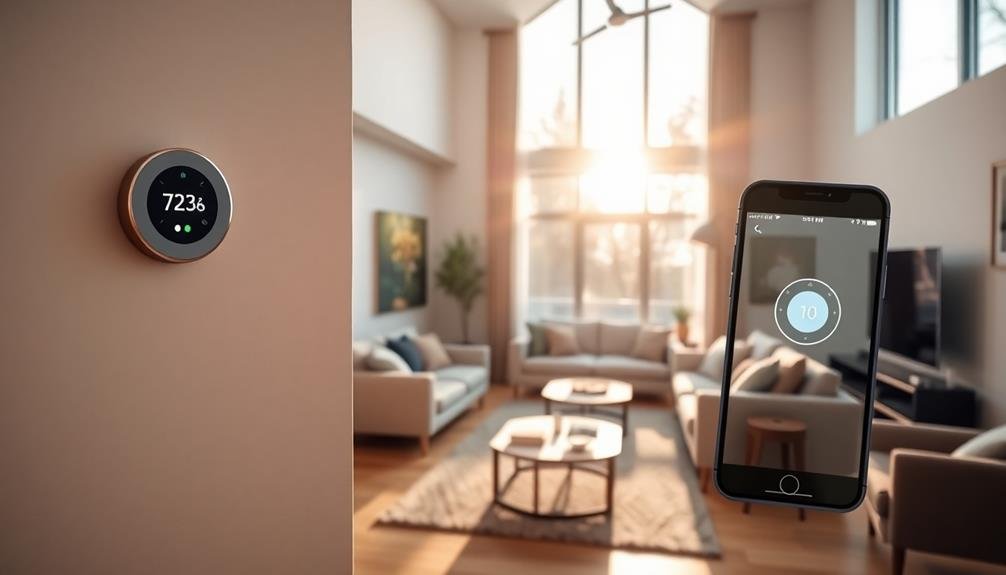
Implementing smart control systems can revolutionize your home's heating efficiency and comfort. These advanced systems allow you to control your heating remotely, set schedules, and even learn your preferences over time. You'll have the ability to adjust temperatures from your smartphone, ensuring your home is warm when you arrive and saving energy when you're away.
Smart thermostats are at the heart of these systems. They can integrate with other smart home devices, like occupancy sensors and weather stations, to optimize heating based on real-time conditions. You can create zones in your home, heating only the areas you're using and further reducing energy waste.
Many smart systems offer detailed energy reports, helping you understand your usage patterns and identify areas for improvement. They can also send alerts for maintenance issues or unusual energy consumption, potentially catching problems before they become costly.
When choosing a smart control system, consider compatibility with your existing heating setup and other smart home devices. Look for systems with user-friendly interfaces and robust customer support.
With the right smart control system, you'll enjoy enhanced comfort, reduced energy bills, and greater control over your home's heating.
Add Thermal Storage Solutions
In recent years, thermal storage solutions have emerged as a game-changer for home heating efficiency.
These systems allow you to store heat during off-peak hours and release it when needed, reducing energy costs and improving overall comfort. By implementing thermal storage, you'll benefit from a more stable temperature throughout your home and lower your carbon footprint.
There are various thermal storage options to evaluate, each with its own advantages:
- Water tanks: Store hot water for later use in radiators or underfloor heating
- Phase change materials: Absorb and release heat at specific temperatures
- Ceramic bricks: Retain heat for extended periods and release it gradually
- Underground thermal banks: Use the earth's natural insulation properties
- Ice storage systems: Utilize the energy released during phase changes
When selecting a thermal storage solution, assess your home's size, existing heating system, and local climate.
You'll need to work with a professional to determine the most suitable option and guarantee proper installation.
While the initial investment may be significant, the long-term energy savings and increased comfort make thermal storage a worthwhile upgrade for many homeowners.
Don't forget to pair your thermal storage system with smart controls for peak efficiency and performance.
Optimize Air Distribution Methods
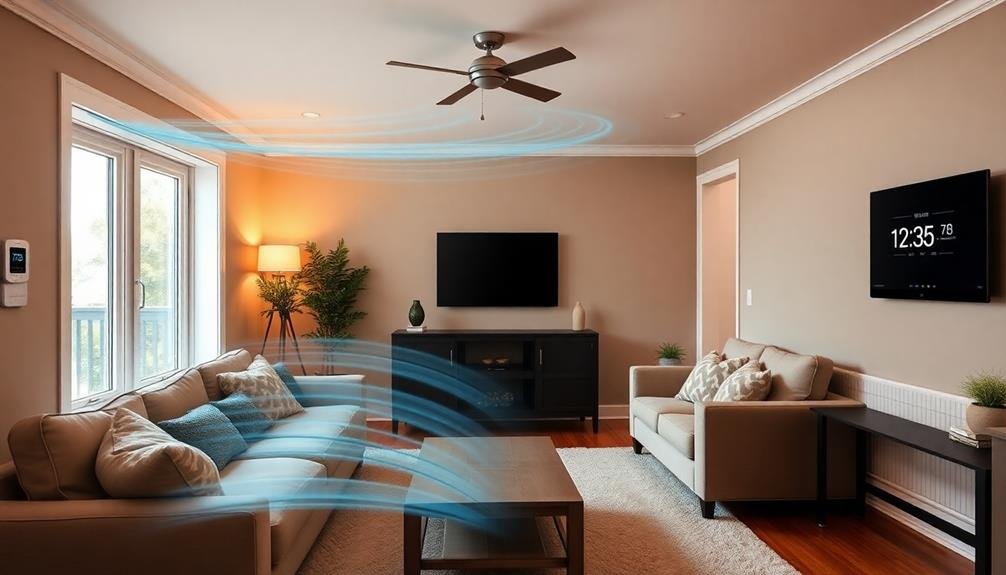
Your home's air distribution system plays an essential role in heating efficiency and comfort. To optimize it, start by sealing any leaks in your ductwork. This prevents heated air from escaping into unconditioned spaces, ensuring it reaches its intended destination. Use mastic sealant or metal-backed tape for a durable fix.
Next, insulate your ducts, especially those running through unheated areas like attics or crawl spaces. This minimizes heat loss as air travels through the system.
Consider installing a zoning system, which allows you to control temperatures in different areas of your home independently. This way, you're not wasting energy heating unused rooms.
Don't forget about your vents and registers. Keep them clean and unobstructed to maintain proper airflow. Adjust dampers in your ductwork to balance airflow between different rooms. You can also install smart vents that automatically open and close based on temperature needs.
Lastly, consider upgrading to a variable-speed blower motor in your furnace. It'll provide more consistent airflow and temperature control while using less energy.
Enhance Insulation for Efficiency
While optimizing air distribution is important, proper insulation forms the foundation of an energy-efficient home. Enhancing your home's insulation can greatly reduce heat loss and lower your energy bills.
Start by identifying areas where heat escapes, such as windows, doors, attics, and walls. You'll want to focus on sealing any gaps or cracks and adding insulation where it's lacking.
Think about upgrading to energy-efficient windows and doors, or use weatherstripping to improve their seal. In the attic, verify you have adequate insulation between the joists and think about adding a radiant barrier to reflect heat.
For walls, blown-in insulation can be an effective solution without requiring major renovations.
Here are some key insulation materials to think about:
- Fiberglass batts or rolls
- Spray foam insulation
- Cellulose insulation
- Rigid foam boards
- Mineral wool insulation
Incorporate Backup Heat Sources
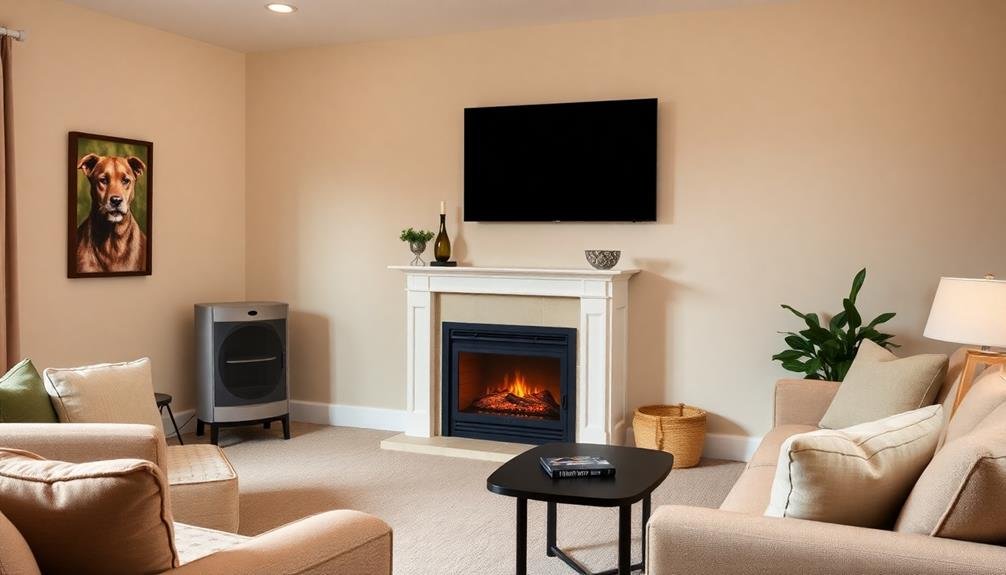
Backup heat sources are essential for maintaining comfort and safety during power outages or primary system failures. You should consider incorporating alternative heating options to guarantee your home remains warm in emergencies.
A popular choice is a wood-burning stove or fireplace insert, which can provide substantial heat without electricity. If you're looking for a cleaner option, pellet stoves offer efficient heating using compressed wood or biomass pellets.
For a more modern approach, you might install a ductless mini-split heat pump system. These units can serve as both primary and backup heat sources, operating on less energy than traditional systems.
Another reliable option is a portable propane heater, which you can easily move between rooms as needed. However, guarantee proper ventilation when using any combustion-based heater indoors.
Consider installing a whole-house generator to power your main heating system during outages. This solution allows you to maintain your regular heating routine without interruption.
Whatever backup heat source you choose, make certain it's properly sized for your space and installed by a professional to guarantee safety and efficiency.
Monitor and Maintain Performance
Regular monitoring and maintenance are essential for ideal heating system performance. You'll want to keep a close eye on your system's efficiency and address any issues promptly to guarantee peak operation.
By staying proactive, you can extend your heating system's lifespan, reduce energy costs, and maintain a comfortable home environment.
To effectively monitor and maintain your heating system's performance:
- Schedule annual professional inspections
- Clean or replace air filters monthly
- Check and clean vents and ductwork regularly
- Monitor energy bills for unexpected increases
- Learn to recognize unusual noises or odors
Don't wait for problems to escalate before taking action. Familiarize yourself with your heating system's normal operation and keep detailed records of maintenance activities. This will help you spot potential issues early on.
Consider investing in a smart thermostat that can provide valuable data on your system's performance and energy usage. If you notice a decline in heating efficiency or comfort, don't hesitate to call a professional.
Frequently Asked Questions
How Long Does It Take to Install a Solar Air Heating System?
You'll find that installing a solar air heating system typically takes 1-3 days. It depends on your home's size, system complexity, and installer expertise. Don't forget to factor in time for planning and permitting beforehand.
What Is the Average Cost Savings of Solar Air Heating Annually?
You can save considerably with solar air heating. On average, you'll reduce your annual heating costs by 20-30%. Your exact savings depend on your location, energy prices, and system size. It's a smart investment for long-term savings.
Can Solar Air Heating Be Used in Colder Climates Effectively?
You can effectively use solar air heating in colder climates. It'll work best on sunny days, even when it's cold outside. You'll need proper insulation and a well-designed system to maximize efficiency in chilly regions.
Are There Government Incentives Available for Installing Solar Air Heating Systems?
You'll find various government incentives for solar air heating systems. These can include tax credits, rebates, and grants. Check with your local and federal energy offices to discover specific programs available in your area. Don't miss out!
How Noisy Are Solar Air Heating Systems Compared to Traditional HVAC?
You'll find solar air heating systems are typically quieter than traditional HVAC. They don't use compressors or fans, relying on natural convection instead. You'll barely notice their operation, enjoying a peaceful home environment.
In Summary
You've now got the tools to transform your home heating with solar air systems. By evaluating your current setup, integrating compatible collectors, and optimizing distribution, you'll create an efficient, eco-friendly heating solution. Don't forget to enhance insulation, implement smart controls, and maintain your system regularly. With these upgrades, you'll enjoy comfortable, sustainable warmth while reducing your carbon footprint and energy bills. Embrace the future of home heating and make the switch today!
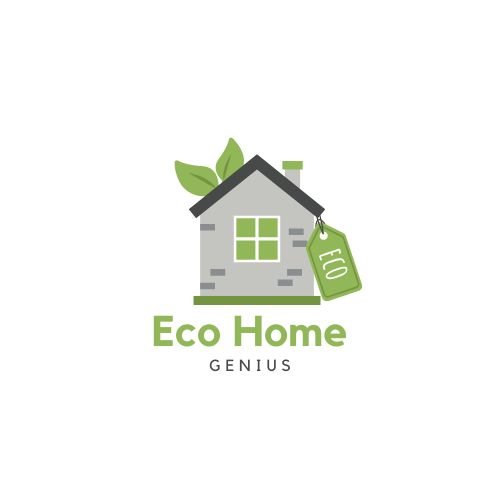

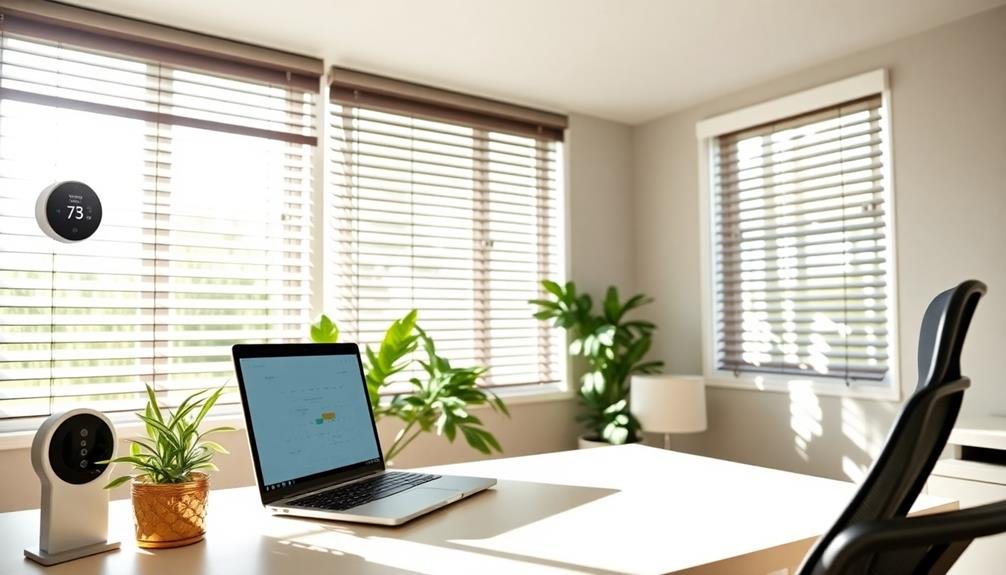
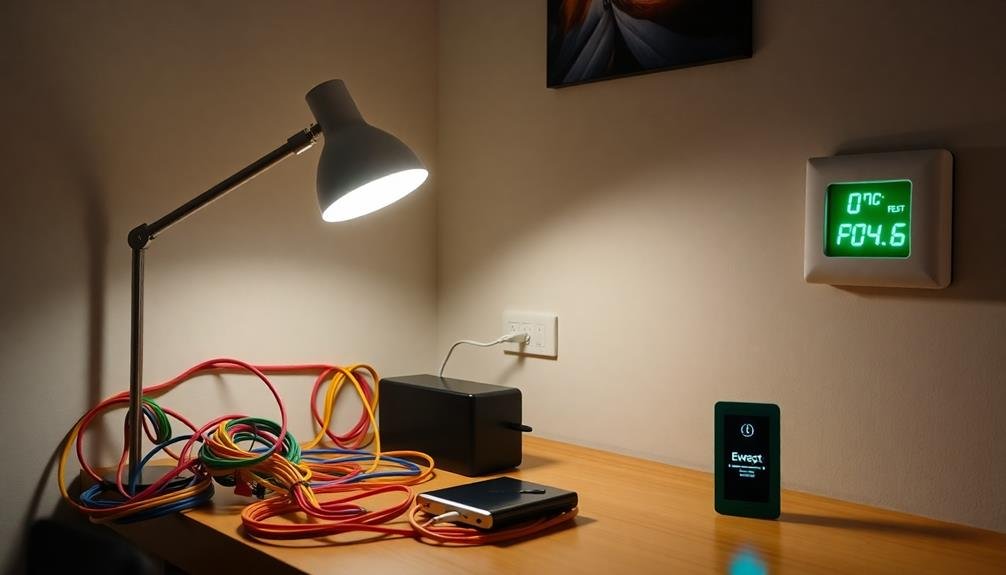
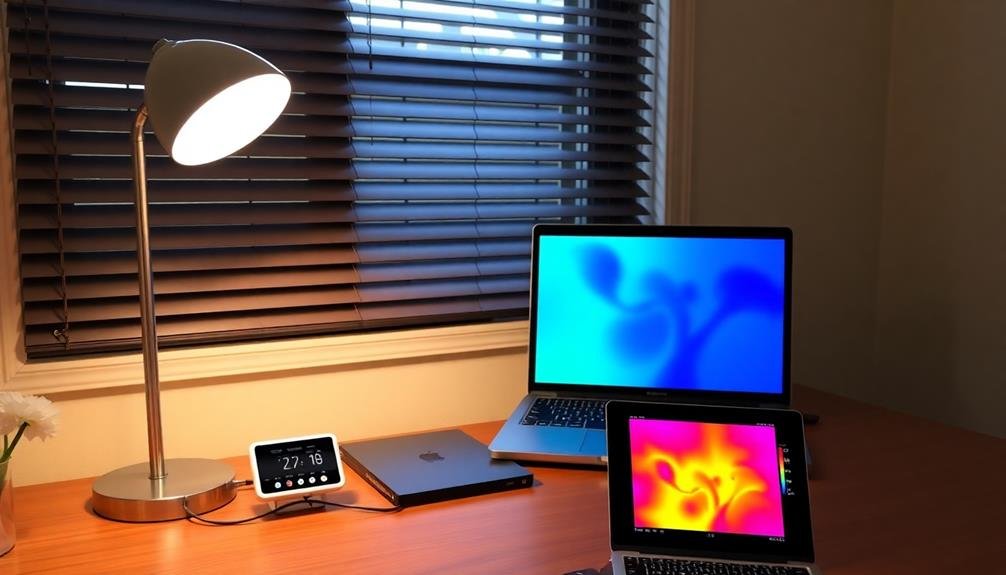
Leave a Reply